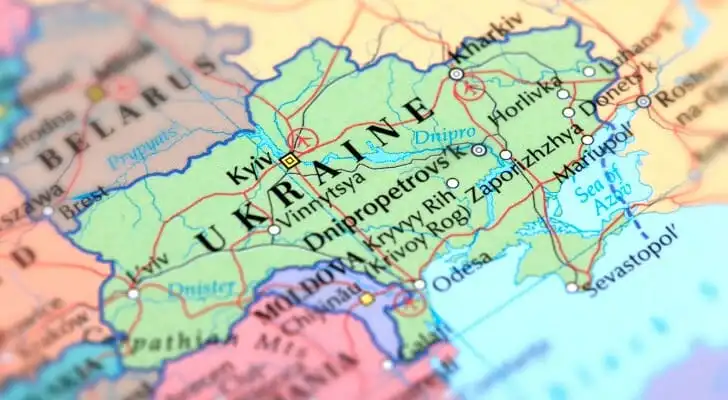 In recent months, investors have contended with the emergence of the Omicron variant, central bank policy tightening and persistent inflation. Now, Russia has invaded Ukraine, igniting a geopolitical crisis that is shaking global financial markets.
In recent months, investors have contended with the emergence of the Omicron variant, central bank policy tightening and persistent inflation. Now, Russia has invaded Ukraine, igniting a geopolitical crisis that is shaking global financial markets.
The three major stock market indexes – the Dow Jones Industrial Average, the S&P 500 and the Nasdaq Composite – have all suffered significant losses in recent weeks as tensions have mounted in Eastern Europe, prompting some investors to wonder whether now is the time to get out of the markets in anticipation of more volatility.
“The short answer: It’s not! In fact, for most long-term investors, it’s probably actually the time to stay (or get) invested,” Elyse Ausenbaugh, a global investment strategist for J.P. Morgan, wrote in a recent commentary.
Recent history shows us that investors, especially those with long time horizons, are wise to ride out times of political and financial crisis. To illustrate this, J.P. Morgan Private Bank tracked the cumulative total return of the S&P 500 since significant domestic or global crises in every year going back to 1999. For example, the index has risen nearly 485% since the dot-com bubble of 2002 when the market fell by almost 50%. Investors who exited the market in response to that event or others like it would have missed out on the robust gains that eventually came later.
Need advice during times of financial volatility? Consider working with a trusted financial advisor who can help manage your portfolio and create a comprehensive financial plan for you and your family.
Why You Shouldn’t Cut and Run During Crises

The stock market has been on a bull run since the early days of the COVID-19 pandemic, when markets plunged in response to the unprecedented health crisis. In fact, the S&P 500 has gained 80% since February 2017, in spite of the pandemic’s economic toll.
While the pandemic has surely been the most consequential global event in decades, it’s not the first crisis to roil financial markets. Looking back over the last 23 years, J.P. Morgan identified moments of significant challenge in practically every year. While these events surely spooked investors at the time, those who remained invested reaped the rewards of what came later.
Here is the cumulative total return* of the S&P 500 since the major events of the last 23 years:
- 1999: 467.1% since Y2K
- 2000: 368.5% since the tech wreck of 2000
- 2001: 415.4% since September 11
- 2002: 484.9% since the dot-com bubble
- 2003: 650.9% since U.S. invasion of Iraq
- 2004: 483.5% since the Boxing Day tsunami
- 2005: 426.2% since Hurricane Katrina
- 2006: 401.6% since Pluto demoted from planet status (not a bad year!)
- 2007: 333.2% since sub-prime blow ups of 2007
- 2008: 310.6% since Global Financial Crisis and bank failures in 2008
- 2009: 551.8% since the depths of the Global Financial Crisis
- 2010: 415.4% since the flash crash of 2010 and BP oil spill
- 2011: 347.9% since S&P downgrades U.S. debt and 50% write-down of Greek debt
- 2012: 338.6% since second Greek bailout
- 2013: 278.1% since “Taper Tantrum” of 2013
- 2014: 185.6% since Ebola epidemic and Russian annexation of Crimea
- 2015: 151.2% since Global deflation scare and China FX devaluation
- 2016: 147.8% since the Brexit vote and U.S. election
- 2017: 121.3% since the fed rate hikes and tensions with North Korea
- 2018: 81.7% since trade war and February inflation scare of 2018
- 2019: 90% since trade war, impeachment inquiry and global growth slowdown of 2018
- 2020: 44.5% since the start of the COVID-19 pandemic and U.S. election
- 2021: 22% since emergence of Omicron variant and Chinese regulatory crackdown
*Cumulative total return for the S&P 500 was calculated from Dec. 31 of the previous year to Jan. 31, 2022, according to J.P. Morgan Private Bank
That’s not to suggest that investors should dismiss risk, like the threat of war in Ukraine. But as Ausenbaugh notes, “markets tend to right themselves as those risks pass.”
Don’t Try to Time the Market
 If the J.P. Morgan data does little to assuage your immediate worries related to Ukraine and you’re dead set on cashing out your portfolio, beware that perfectly timing your exit is all but impossible. Market timing strategies are hypersensitive and can easily leave you with less money in the long run compared to simply staying invested through market turmoil.
If the J.P. Morgan data does little to assuage your immediate worries related to Ukraine and you’re dead set on cashing out your portfolio, beware that perfectly timing your exit is all but impossible. Market timing strategies are hypersensitive and can easily leave you with less money in the long run compared to simply staying invested through market turmoil.
Over the last 20 years, seven of the best 10 days in the markets have occurred within approximately two weeks of the 10 worst days, according to Ausenbaugh, a chartered financial analyst (CFA). That means investors who cut bait immediately after the worst days likely missed out on the brighter days that followed thereafter.
“So next time market volatility feels scary enough to make you second guess your long-term investment strategy, have a good think before you get out of the market,” she wrote. “There could be a 70% chance you’ll miss one of the best days.”
Furthermore, mistiming your exit from or reentry into the market by a wider margin can have even more dire consequences. Bob French, a CFA and director of investment analysis for Retirement Researcher, recently found that a buy-and-hold investor would have had $5,800 in 2016 for every dollar invested in the S&P 500 nine decades earlier. Missing just the single best month during that timespan, however, would have reduced the investor’s return by 30%, French found.
Forgoing the top 5% of months between 1926 and 2016 would have left the investor with $2,937 for every dollar invested in the S&P 500 – nearly half as much as the buy-and-hold strategy, according to French’s analysis.
But beyond standing pat, how else should you respond to times of volatility? According to Ausenbaugh, stay diversified, keep your emotions in check and consider the potential benefits of active management and thoughtful portfolio construction.
“Diversification, time in the market and a steady head can help investors achieve their long-term financial goals by avoiding the pitfalls of emotionally driven, badly timed mistakes,” she wrote. “When times get tough in markets and make you feel nervous, remember the lessons from tried-and-true investing principles.”
Bottom Line
The threat of war in Ukraine has shaken markets in recent weeks and left investors concerned about what is to come. Despite the impulse to cash out your retirement portfolio, investors with longer horizons would be wise to ride out the market volatility. S&P 500 historical data compiled by J.P. Morgan shows how the index has responded and recovered from other political and financial crises through the years. Timing the market is not only hard to do, but can easily result in missing out on the gains that follow these types of crises.
Tips for Investing During Volatile Times
- Don’t underestimate the benefits of working with a financial advisor. Not only can a professional manage your portfolio and create a financial plan for you, a financial advisor can help you take the emotion out of investing. Finding a qualified financial advisor doesn’t have to be hard. SmartAsset’s free tool matches you with up to three financial advisors who serve your area, and you can interview your advisor matches at no cost to decide which one is right for you. If you’re ready to find an advisor who can help you achieve your financial goals, get started now.
- Having an asset allocation that aligns with your risk tolerance and investing goals is key. SmartAsset’s asset allocation calculator can help determine the right mix of stocks, bonds and cash for you.
Photo credit: iStock.com/omersukrugoksu, ©iStock.com/Maximusnd, ©iStock.com/Delmaine Donson